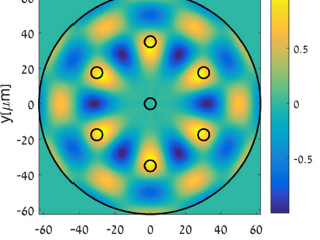Fiber Opto-Mechanics
We are often accustomed to think of the propagation of light and sound waves as two separate phenomena. This conception is, however, incorrect. Many optical waveguides also support guided acoustic modes. These modes may be stimulated by guided light waves through the physical mechanism of electrostriction and may scatter light waves via photo-elasticity.
Standard optical fibers support a variety of acoustic mode that are guided by their entire cladding cross-sections. The acoustic modes may be driven by a pair of co-propagating optical tones. The effect is referred to as forward stimulated Brillouin scattering, of forward SBS. We study this mechanism in standard optical fibers and fibers containing multiple cores, and find that these processes have surprising implications. 1) They enable optical measurements of substances outside the cladding of a standard fiber, where light does not reach. 2) They introduce cross-talk among multiple fiber cores, even when these cores are completely isolated from one another optically. 3) They may give rise to narrowband phononic oscillations in a hybrid electro-opto-mechanical cavity.
Recent research highlights include the distributed mapping of media outside the fiber with few cm resolution, the analysis of fiber coating layers, detection of gamma radiation, demonstration of non-reciprocal propagation effects in polarization-maintaining fibers.


• Y. Antman, A. Clain, Y. London, and A. Zadok, "Optomechanical sensing of liquids outside standard fibers using forward stimulated Brillouin scattering," Optica 3, 510-516 (2016).
• G. Bashan, H. H. Diamandi, Y. London, E. Preter, and A. Zadok, "Optomechanical time-domain reflectometry," Nature Commun. 9, 2991 (2018).
• G. Bashan, Y. London, H. H. Diamandi and A. Zadok, "Distributed cladding mode fiber-optic sensor," Optica 7, 85-92 (2020).
• H. H. Diamandi, Y. London, A. Bergman, G. Bashan, J. Madrigal, D. Barrera, S. Sales, and A. Zadok, "Opto-mechanical interactions in multi-core optical fibers and their applications," invited paper, IEEE J. Selected Topics in Quantum Electronics 26, 2600113 (2020).
